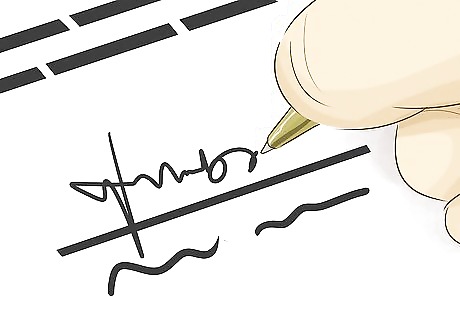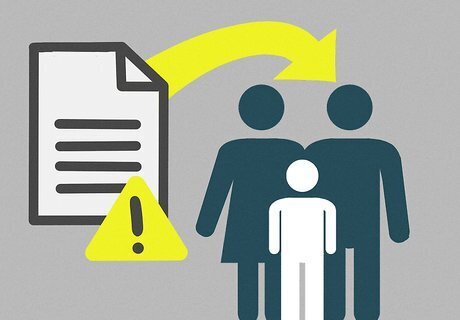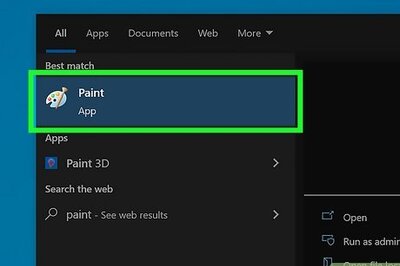
views
X
Research source
[2]
X
Research source
Establishing Paternity

Seek voluntary acknowledgement. You must establish paternity if you are not married to the father of your child. The easiest way to do this (assuming you are still on good terms with him) is to have him sign a voluntary acknowledgement of paternity. In some states, the man listed on the birth certificate is automatically considered the child's father unless he petitions the court with a denial of paternity. If no one is listed on your child's birth certificate as the father, you must establish paternity. The voluntary acknowledgement of paternity form is free, typically available either from the clerk of the county family court or at the local office of your state's child support agency. You also may be able to find a copy of the form available for download online. Just make sure the form you're using is one accepted in your county. If you are uncertain about who might be the father of your child, you should contact your state's child services agency. They will assist you in getting the DNA tests necessary to establish paternity.

Request an agreed paternity order. Depending on the laws in your state, you may have to file a petition for an agreed paternity order with the court even if the father of your child has signed a voluntary acknowledgement. This typically is required if there is no father listed on your child's birth certificate, because you must get the court to approve the validity of the voluntary acknowledgement. The forms to request an agreed paternity order can be found at the clerk's office or at your state's child support agency. Since it is an agreed order, the process is simpler than if the alleged father contests paternity. You typically don't have to serve him with the papers, and the entire court process only takes a few minutes. You may be charged court fees for this, typically under $100. If you cannot afford these fees or are receiving public assistance, ask the court clerk for an application for a fee waiver.

File a petition to establish paternity. If the father of your child refuses to sign a voluntary acknowledgement, you must file a petition with the family court and have a judge issue a paternity order following the results of DNA tests. You typically can find forms to fill out by visiting the clerk's office of the court in the county where your child resides. You also can choose to work through your state's child support agency to establish paternity. This may be an easier and more cost-effective option since typically the child support agency will file the documents and appear in court on your behalf. In some states, you're required to work through your state's child support agency if you are currently receiving public assistance. As with requesting an agreed order, you typically will be charged court fees if you don't work through the child support agency. Ask the clerk for a fee waiver if you don't believe you can afford these fees.

Get paternity tests. To establish paternity through DNA testing, you and your child must get tested along with the alleged father. The results of the test will determine whether the man tested is the biological father of your child. Keep in mind that over-the-counter DNA tests such as the kits you might buy in a drug store cannot be used as evidence in court. You must get the tests done at a lab approved by your state's court system. If you work through your state's child support agency you often won't have to pay for the costs of DNA testing to establish paternity.

Receive the court's order. Whether you've asked for an agreed order or took DNA tests to establish paternity, you typically must attend a brief court hearing in which the judge will review the evidence and issue an order declaring the father of the child. DNA tests are 99 percent accurate. If the DNA test reveals the man tested is the father of the child, the judge will issue a paternity order. #*If the DNA tests are inconclusive or rule out the man as the father of the child, you must return to court after another man is tested. You must use the court's paternity order to request an order for child support.
Filing a Petition for Child Support

Work with your state's child support agency. If you are receiving public assistance, your state's child support agency will establish paternity and file the necessary petitions in court to start collecting child support from your child's father. In most states, the child support agency will automatically start the proceedings to collect child support from the father if you are receiving public assistance such as Temporary Assistance for Needy Families (TANF). Even if you're not receiving public assistance, you may want to consider using the state child support agency to collect child support from your child's father rather than going to court yourself. You may be charged a small fee for using the state agency if you're not on public assistance, but it typically will be less than what you would pay in court fees. Working through your state's child support agency may be especially beneficial if the father of your child is abusive and you fear for your safety or the safety of your child, because you can collect child support with minimal to no contact with the father.

Find the appropriate forms. Most states have fillable forms available to petition the court for child support once you've established paternity. You can get a copy of the forms at the court clerk's office, or you may be able to download them from the court's website and fill them out at home. If you download forms, make sure they're the correct forms for the county in which you plan to file your petition. While child support laws typically are the same throughout the state, each county may have slightly different forms or processes. Read over the forms carefully. If you're unsure how to answer any of the questions, you typically can ask the clerk. However, keep in mind that the court clerk cannot give you legal advice on your case. Some courts also have a family law facilitator who is there to answer questions about family court documents such as child support petitions.

Complete your forms. Typically there will be several forms you must fill out to ask the court to order child support, including a form that asks for details about your income and expenses. Unless you and your child's father have come up with an agreement on your own, this information will be used to help determine how much child support he must pay. The petition itself includes basic information about yourself and your child, states that paternity has been established, and asks the court to order the father to pay child support. Typically you must attach a copy of the court order establishing paternity to your petition. You also must complete another form that contains details about your household's finances, including the number of people who live with you, their monthly income, and your average monthly expenses. You may be required to attach proof of expenses and income in some cases. If the court requires you to file proof with your form, it will say so on the form. You also may be required to sign the income and expenses form in the presence of a notary public. You typically can find a notary at the courthouse. Most banks also provide notary services for their customers.

File your forms. To get a court order for child support, you must file your petition in the county court where the child lives. In some states you can file this form in the county civil court, while others require the form to be filed with a specific family court. You will need at least two copies of your signed documents in addition to the originals. If you have the means to do so, you may want to go ahead and make these copies before you go to the clerk's office. The clerk will make copies for you, but they typically charge a fee. The clerk will stamp your copies "filed" with the date and give them back to you. One copy is for your own records, while the other must be delivered to your child's father. You will be charged a filing fee to file your petition for child support – typically around $100. If you believe you cannot afford the filing fees, ask the clerk for a fee waiver. If your income and assets fall below the court's threshold, you won't have to pay the court costs for your case. Even if you already were granted a fee waiver for a paternity action, you typically must complete another application to cover your child support action.

Have the father served. You must send the forms you filed with the court to the father using a court-approved method, so you can prove to the court that he had adequate notice of the petition and time to respond. Technically, anyone over the age of 18 who isn't associated with your case can hand-deliver the forms to your child's father. This means you can't do it yourself, but you can get a friend or neighbor to do it. However, most people get the sheriff's department or a private process serving company to deliver the papers. You will be charged a small fee for their services. If you get someone to serve the papers, you must have them fill out a proof of service form that you will file with the court. Typically, a sheriff's deputy or private process serving company will already have copies of this form and will file it for you. Check and make sure so you don't end up not filing proof of service by mistake. Once the child's father is served, he has a limited period of time to respond if he wants to contest your petition. He also may respond and agree to it.
Attending Your Court Hearing

Consider consulting an attorney. Although technically you don't need an attorney to represent you in the initial hearing to get child support, you may want one if you anticipate that your child's father will challenge your request for child support or try to fight you on custody. You can find an attorney by searching for family law attorneys in the directory of your state or local bar association's website. This directory will be limited to attorneys licensed to practice law in your state. If you're concerned about the expense of legal fees, you might consider talking to someone in your local legal services office. If you meet their income requirements, you may be able to get free representation. Some courts also have family court facilitators who can answer questions about the forms or court processes for you if you are representing yourself. These facilitators also may be able to provide limited advice, although they cannot represent you in court.

Gather your documents. You will need to bring your copies of everything you filed with the court, as well as proof of paternity, income and financial documents, and anything else that is relevant to the court's calculation and order of child support. Read all your court documents carefully and make sure you understand your own case inside and out. Keep in mind the judge cannot rule on anything other than the issues raised in your court documents. For example, if your court documents only relate to child support, the judge will not decide any issues related to the custody of your child, or visitation by the father. If these issues are raised, they will have to be addressed in another hearing. Get documents together that support the information you put on your forms regarding income and expenses, and organize them in such a way that you can find what you need quickly if asked. Make sure you bring your copies of all documents related to the court case, including any documents you've filed or any documents from the father that have been served on you. You also want to read and familiarize yourself with your state's child support guidelines. This is how the judge will determine how much child support your child's father must pay. If you have time before your hearing is scheduled, you may want to go to the court where your case will be heard and sit in on some other cases, just so you have an idea of how the judge handles their courtroom and what will be expected of you.

Appear for your hearing. While you don't have to wear a suit, you should dress in neat, clean professional clothing for your hearing. Think about what you would wear to a job interview. Arrive at the courthouse at least 30 minutes before the time your hearing is scheduled so you have time to go through security and find the correct courtroom. When you get to the courtroom, take a seat in the gallery. The judge typically will be hearing several cases on the same day, so wait until your name is called before you move to the front of the courtroom. You may have an opportunity to exchange documents with the father and discuss the matter before the judge listens to your case.

Present your case to the judge. Since you filed the petition, you typically will have the first opportunity to talk to the judge and explain what it is you want the court to do. Speak in a clear, distinct voice that's loud enough for the judge to hear. The judge will talk to both you and the child's father to find out about your finances, how much child support is being asked for, and how much time both of you spend with the child. If custody or visitation issues arise during the course of the proceeding, the judge may decide them right then, but typically the judge will schedule another hearing. Remember to remain calm, and speak to the judge – not to your child's father. If the judge interrupts you with a question, stop speaking and answer the question. You can pick up where you left off when the judge indicates he or she is satisfied with your answer.

Receive your order. After hearing from you, and from your child's father if he showed up, the judge will make his or her decision on whether to set up child support or arrange another hearing. If the judge decides to set up child support, you typically must fill out forms to register for child support and enforce the child support order. Either you or your child's father will be responsible for preparing the findings and order for the judge to sign. If either of you has an attorney, the judge typically will have the attorney do it. Some states require you to prepare an order when you file your petition. If the judge approves everything you asked for, he or she may simply sign this document. If you requested a child support order through your state's child support agency, a counselor from the agency will assist you in filling out the forms you need to enforce the court's order. If you got your child support order through the courts on your own, you must work with the court to enforce the order through a wage assignment. The court clerk will have forms and information for you on how to do this.



















Comments
0 comment